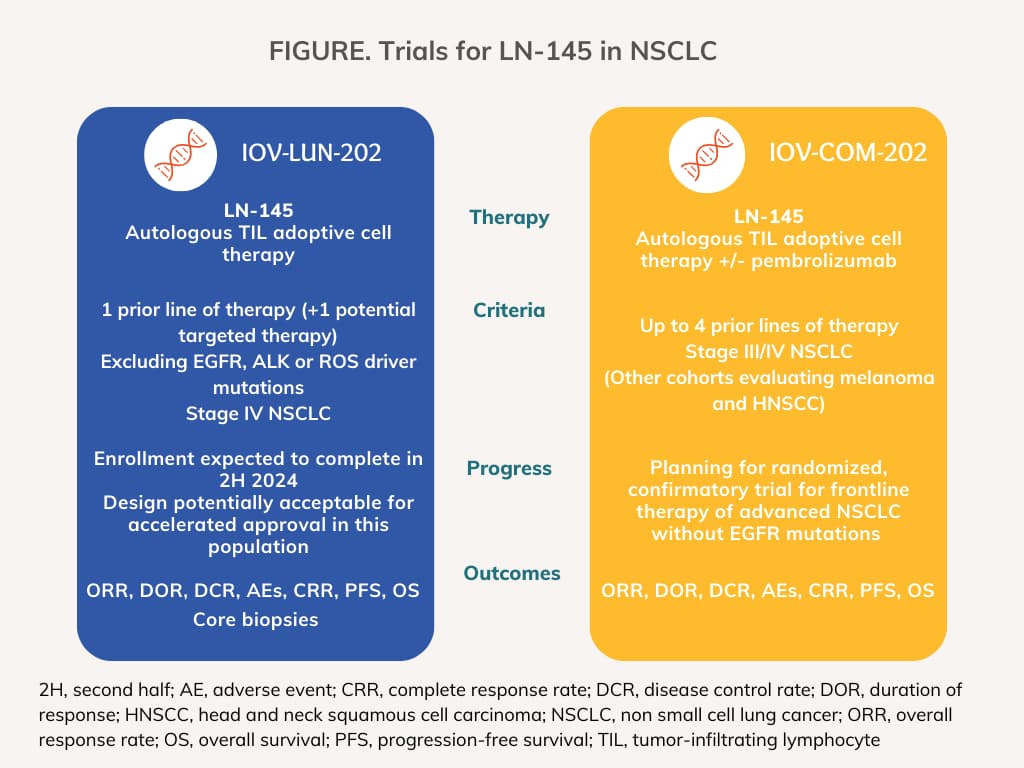Iovance’s NSCLC Trials Push Second TIL Therapy Closer to Submission
The PDUFA date for Iovance’s lead TIL lifileucel for melanoma was recently pushed back to February 24, 2024.
Iovance Biotherapeutics is working on bringing its second lead tumor infiltrating lymphocyte (TIL) therapy, LN-145, to the clinic for patients with advanced post non–small cell lung cancer (NSCLC).
The TIL therapy is being evaluated in 2 ongoing clinical trials for NSCLC, for patients with NSCLC, with up to 4 prior lines of therapy, including post anti-PD-1 therapy in the phase 2 IOV-COM-202 trial (NCT03645928) and as a second-line treatment for patients post-chemotherapy and post anti-PD-1 therapy in the phase 2 registrational IOV-LUN-202 trial (NCT04614103).
IOV-COM-202 trial is investigating the TIL adoptive cell therapy in patients with NSCLC in cohorts 3A, 3B, and 3C; patients with melanoma in 1A, 1B, and 1C; and patients with head and neck squamous cell carcinoma (HNSCC) in cohort 2. Participants receive a nonmyeloablative (NMA) lymphodepletion regimen, followed by infusion of autologous TIL and then administration of an IL-2 regimen. FIGURE.
FIGURE.

Focusing on participants with NSCLC, cohorts 3A and 3C will receive TIL plus checkpoint inhibitors (CPI) and cohort 3B will receive it as a monotherapy. Participants must have Stage III or Stage IV NSCLC. Patients in cohort 3A must have CPI-naïve disease and patients in cohorts 3B and 3C must have received prior CPI treatment. Participants must have at least 1 resectable lesion, measurable disease as defined by RECIST 1.1 following tumor resection, be between 18 and 70 years of age, use an approved method of birth control, have an Eastern Cooperative Oncology Group (ECOG) performance status of 0 or 1, and an estimated life expectancy of at least 6 months.
READ MORE: Lifileucel's Phase 3 TILVANCE-301 Trial Kicks Off in Patients With Melanoma
IOV-COM-202's primary outcome measures are objective response rate (ORR), and safety profile/incidence of serious treatment-emergent adverse events (AEs). Secondary outcome measures include complete response rate (CRR), duration of response (DoR), disease control rate (DCR), progression-free survival (PFS), and overall survival (OS).
The most recent data from the trial were reported on cohort 3A in January 2023, in which patients received anti PD-1 therapy pembrolizumab (Keytruda) in combination with LN-145. Among 17 patients treated in this cohort, the ORR was 47% (n = 8) and responses were similar regardless of their PD-L1 status. Furthermore, the subset of 5 patients who were treatment-naïve had an ORR of 80% (n = 4), the subset of 7 patients who had previously been treated with chemotherapy, but not antiPD-1 therapy had an ORR of 43% (n = 3), and the subset of 5 patients who had EGFR mutations and had previously been treated with tyrosine kinase inhibitor therapy had an ORR of 20% (n = 1). One of the patients in cohort 3A who had previously been treated with chemotherapy, but not anti PD-1 therapy and 1 of the patients who had EGFR mutations and had previously been treated with TKI therapy each achieved a CR. In terms of safety, results were consistent with Iovance’s other assessments of TIL therapies in combination with pembrolizumab.1
Iovance is waiting to discuss the cohort 3A data and plans for a randomized confirmatory study to evaluate LN-145 in combination with pembrolizumab as a frontline treatment in patients with advanced NSCLC who do not have mutations in EGFR with the FDA.
IOV-LUN-202 is evaluating TN-145 with the same regimen as IOV-COM-202 in 4 cohorts. These cohorts consist of patients with no PD-L1 tumor expression, with PD-L1 expression, regardless of expression and ineligible for resection, regardless of expression who elect to produce the autologous TIL cells prior to disease progression, and a retreatment cohort, respectively. The trial’s primary outcome measure is ORR and secondary outcome measures include CRR, DoR, DCR, PFS, OS, AEs, and core biopsies.2
Inclusion criteria for IOV-LUN-202 is similar to that of IOV-COM-202, although patients must have metastatic Stage IV NSCLC without EGFR, ALK or ROS driver mutations. Patients who have actionable mutations other than those require 1 additional prior targeted line of approved therapy.
The most recent data from IOV-LUN-202 are from 23 patients treated in the trial as of July 6, 2023. ORR was 26.1% (n = 6), with 1CR, and 5 partial responses. DCR was 82.6% and DOR ranged from 1.4+ months to 9.7+ months (median not reached). Again, there were no new unexpected AEs of interest compared to the established safety profile of the company’s TIL therapies.2
Iovance has shared that the FDA regarded the design of the IOV-LUN-202 trial potentially acceptable for accelerated approval of LN-145 in this population. The company plans to enroll around 120 patients into the trial, with enrollment expected to complete in the second half of 2024.
